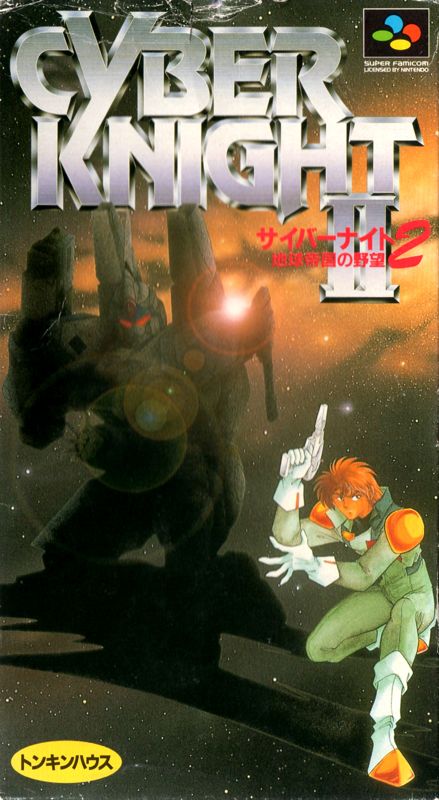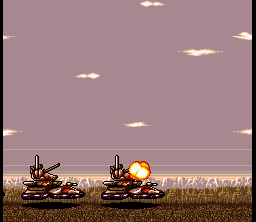Retro Replay Review
Gameplay
Cyber Knight II: Chikyū Teikoku no Yabō expands upon the original’s hybrid exploration and combat systems with refined mechanics that reward strategic thinking. Planetary movement still employs a top‐down view, allowing you to guide the Galvodirge crew across alien landscapes, interact with NPCs, and uncover hidden gateways. Towns and civilized outposts retain their familiar layouts, but many hazardous zones now require deployment of specialized combat modules—small mechs that introduce fresh tactical layers to each mission.
(HEY YOU!! We hope you enjoy! We try not to run ads. So basically, this is a very expensive hobby running this site. Please consider joining us for updates, forums, and more. Network w/ us to make some cash or friends while retro gaming, and you can win some free retro games for posting. Okay, carry on 👍)
Combat is divided into two distinct phases: a “support strike” initiated by your secondary team, followed by a turn‐based skirmish in a side‐view arena. Support modules can rain down missiles or deploy shields before the main engagement, giving a satisfying sense of coordinated assault. Once the action shifts to the 6×6 grid, positioning your three primary mechs becomes paramount; each has unique movement ranges, weapon arcs, and consumable “option” attacks. With no ammunition limits, you’re encouraged to mix melee blades, long‐range rifles, and explosive devices in creative combinations.
Resource management differs from typical RPGs, eschewing currency in favor of NeoParts scavenged from fallen Metalliforms. Returning to the Galvodirge’s lab to analyze these tech scraps feels rewarding, as each analysis permanently boosts a module’s agility, accuracy, or endurance—or unlocks devastating new armaments. The absence of shops means every mission feels consequential; skipping a battle to conserve repair kits or first aid supplies can lead to tough choices later on.
Graphics
Given its early ’90s origins, Cyber Knight II’s pixel art remains impressively detailed. The top‐down exploration segments feature richly colored tilesets that distinguish barren wastelands from lush jungles and industrial complexes. Background sprites often include atmospheric touches—rusting machinery, drifting clouds of toxic gas, and flickering power conduits—that bring each locale to life.
Side‐view combat arenas excel in readability and style. Each mech is rendered with distinctive silhouettes, clear weapon mounts, and smooth animation cycles for walking, firing, and taking damage. Enemy Metalliform designs range from insectoid crawlers to towering dreadnoughts, ensuring each battlefield encounter feels visually fresh. Explosions and beam effects, though simple by modern standards, boast crisp palette transitions that pop against darker backdrops.
The user interface employs a first‐person perspective when you’re aboard the Galvodirge, featuring tactile buttons and readouts that evoke classic sci‐fi cockpits. Scan results, mission logs, and NeoPart analyses display in clean text windows with minimal clutter. While the overall aesthetic leans on retro conventions, the consistent attention to color choice, sprite clarity, and thematic iconography makes navigation intuitive and engaging.
Story
Picking up after the fall of the Berzerkers in Cyber Knight, the sequel plunges you into a galaxy on the brink of civil war. General Forrest’s coup of the Earth Federation introduces genuine stakes: the Swordfish crew—once heroes—are now fugitives branded as traitors. This inversion of roles lends emotional weight to every mission, as you fight not only for survival but to vindicate your comrades.
The narrative unfolds through planet‐side interactions, overheard dialogues, and data logs you scan in space. While the core plot drives you toward liberating key systems and sabotaging Overtech research facilities, side quests allow you to assist beleaguered colonies, earn allies, and expose the full extent of Forrest’s tyrannical ambitions. The mysterious agent “CJ” offers cryptic guidance, and occasional allegiances shift, keeping the story’s momentum brisk and unpredictable.
Dialogue writing balances earnest sci‐fi drama with occasional touches of humor—friendly banter among the Swordfish crew lightens the tension of high‐stakes infiltration missions. Characters are sketched rather than deeply profiled, but their motivations feel clear: loyalty, revenge, hope for a free humanity. For players seeking a classic JRPG storyline with moral dilemmas and political intrigue, Cyber Knight II delivers a surprisingly mature sci‐fi yarn.
Overall Experience
Cyber Knight II is a product of its era, blending exploration, strategy, and RPG progression in a package that demands patience and thoughtful planning. Early sections can feel grindy—NeoParts are scarce at first, and some bosses require careful stat boosts to defeat. However, once you unlock a diverse stable of modules and master support/combat team coordination, battles become deeply satisfying puzzles rather than mere stat checks.
The lack of a traditional economy streamlines gameplay, focusing your attention on mission objectives instead of currency hoarding. This design choice strengthens the game’s narrative drive: every scrap of Overtech you recover directly translates into battlefield superiority. The ship‐to‐ship scanning and star‐system navigation mechanics also add a welcome sense of scale, as you chart a campaign from Earth’s doorstep to the farthest independent colonies.
While modern gamers may balk at some dated interfaces and slower pacing, Cyber Knight II stands out as a thoughtful hybrid of RPG and mech‐combat genres. Its strong tactical combat, evocative pixel art, and morally charged storyline make it a compelling journey for fans of retro sci‐fi. If you’re looking for a game that marries classic JRPG sensibilities with strategic mech battles, the Swordfish crew’s second outing is well worth embarking upon.
 Retro Replay Retro Replay gaming reviews, news, emulation, geek stuff and more!
Retro Replay Retro Replay gaming reviews, news, emulation, geek stuff and more!









Reviews
There are no reviews yet.